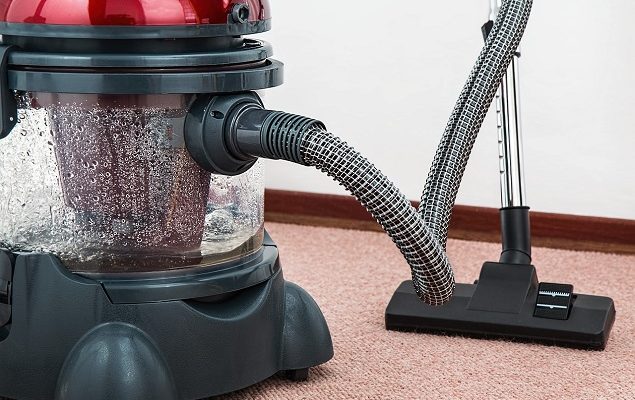With so many high-end and budget vacuum cleaners, it can be difficult to choose one that matches your preferences and your home environment. We’ve compiled this guide to buying a vacuum cleaner to quickly help you understand the main types of vacuums and their differences. So check out our vacuum cleaner buying guide before you spend your money and see which one will suck just the way you like it!
Cordless/Handheld Vacuums
Many people think about corded vs. cordless vacuum cleaners before deciding to invest in a product that suits them best. There are several cordless and handheld types that could appeal to you. That will depend on the surface you are cleaning and your desired runtime.
The most common cordless products are stick vacuums. They are similar to standard upright models. However, they are smaller, thinner, and have a narrower cleaning range. Since they have no cord, they are battery-powered and can run for about 20 minutes to an hour. Most models only use suction, while others have a mechanical brush that can clean carpets and similar surfaces.
Also, some products are convertible into handheld vacuums. They may include dusting tools. Cordless stick vacuums don’t have the power of full-size corded models. This makes them sufficient for light home cleaning or for vacuuming apartments with smaller surfaces.
Upright Vacuums

Corded upright vacuums are similar to cordless stick variants. However, they have more power and are great for cleaning multiple surfaces in your home. That includes drapes, upholstery, and similar. Most products for this type of vacuum will have beater bars with rotating brushes. This is effective for cleaning debris and dirt. Another benefit of upright models is that they are easy to store in a closet or storage room.
Moreover, many products will offer several convenience features. Some are height adjustment, brush roll control, and configurable suction control. Because of that, you can use an upright vacuum for any floor or carpet type.
However, they have some downsides, including making it incredibly difficult to clean stairs. Also, they are much bulkier and heavier compared to canister vacuums. For instance, they may not work for cleaning upholstery and small surfaces or details under your bed or furniture. Also, most will not include a retractable power cord, which could be a nuisance to some people.
Canister Vacuums
When it comes to canister vacuums, they are the most classic and affordable option. They feature a separate housing and flexible hose/nozzle configuration. The canister houses the filters, motors, and the bin/dust bag. It ensures a low profile and a decent weight that won’t drag you down. Plus, since the hose is separated, you can easily clean tough to reach spots. That includes spaces underneath your bed/furniture, corners, bathrooms, etc.
Some products that do not feature mechanical floor nozzles are effective for low/medium pile carpeting. Conversely, canister vacuums with motorized nozzles are incredibly efficient for deep pile carpeting. Moreover, canister vacuums can include multiple attachments that will make it easier for you to clean almost any spot.
Another benefit is their low noise level. However, you may have to assemble them on your own at first. They are also a bit bulky in terms of storage. Plus, canister vacuums may not be the best fit for people with back problems. They require you to constantly bend over and drag the canister behind you while cleaning.
Robotic Vacuums

The technology of robotic vacuum cleaners has improved a lot in recent years, making them much more effective than being mere novelty gadgets. Nowadays, you can find robotic vacuums with smart sensors and navigation systems. They can map out your home and clean most surfaces correctly.
Furthermore, the sensors can automatically stop the vacuum if it gets close to a flight of stairs or similar. Some products also have boundary sensors. This can stop the vacuum from entering an “off-limits” space, such as a play area for your children or dog. What’s more, they are most effective for low-pile carpeting and bare floors. Robotic vacuums have spinning brushes on their sides as well as a brush roll that enables them to clean debris, dirt, and dust.
As expected, you can pair them with your smartphone and use an app to monitor their settings. Some include timers and smart scheduling, while others provide a convenient charge-and-resume option. This feature will automatically command the vacuum to go back to its docking station when its power runs out. However, the technology is still not flawless. Many vacuums could get stuck in curtains/cables, or they could suck up small objects that could damage them.
Main Considerations
Of course, the list of pros and cons is much bigger for each type. Before you make your purchase, you should investigate each option in great detail based on your home’s needs. There are many other considerations that you should take note of before buying a vacuum cleaner.
For example, we haven’t brushed on the bag or bagless options so far. Would you prefer to use replaceable bags or choose a more eco-friendly option with a cup or container? Bagged vacuums are the least messy, and they are much healthier for people who suffer from allergies. Many contain built-in filters, meaning that you may not have to clean your vacuum’s filters. Yet, bagless vacuums are better for the environment and will not require you to constantly invest in new bags. Additionally, they can hold less dirt compared to bagged variants.
Also, what about HEPA filters? A vacuum with HEPA filtering allows you to vacuum and trap dust/dirt that is not visible with the naked eye. The sealed system also doesn’t release allergens into your home during use. If you’re in Europe, HEPA filtration is referred to as S-class. Most models with those classifications have a dust retention rating of 99.9% as opposed to 96% for standard vacuums. Although they are more expensive, HEPA vacuums are much better for those with allergy issues.
Finally, consider your power needs and extras that each type will include. This will depend on your home, your style of cleaning, carpeting, furniture, etc. When it comes to power, 250 to 320 watts will be enough for smaller apartments. They can clean hardwood floors, tiles, linoleum, and various smooth surfaces. However, for carpets and deep cleaning, you should be aiming at 400 to 450 watts.
Key Takeaways

Hopefully, this buying guide has covered everything you need to know to buy a good vacuum cleaner that sucks (in a good way!). So take a look at some vacuum cleaners today and good luck!




